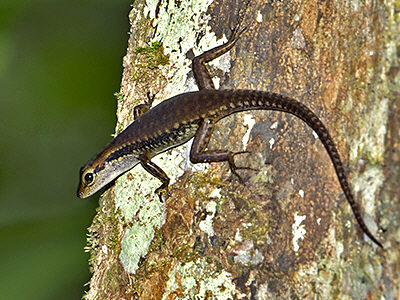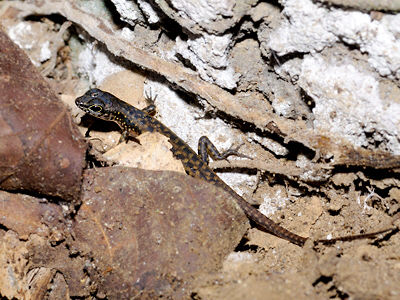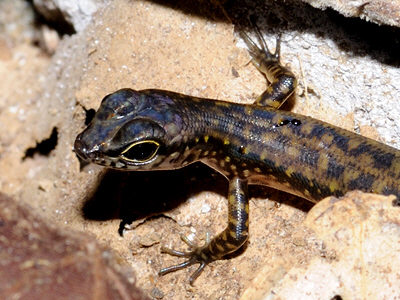
Fig 1

Fig 2

Fig 3
|
Family : SCINCIDAE
Species : Sphenomorphus cyanolaemus
Size (snout to vent) : 6 cm
Size (total length) : 14 cm
This slender-bodied skink
inhabits lowland rainforest up to elevations of 850 metres. It prefers
largely to remain on the forest floor, searching amongst leaf litter
for its prey, but is also known to climb short distances up tree trunks. It
probably feeds on forest floor insects.
The species is identified by the dark dorso-lateral band which runs along
the length of each flank : this is adorned above and below by yellow-gold
flecks, spots or blotches. Its dorsal surface has a complex pattern of
yellow-brown and dark brown mottling. Males are pale blue on
the forward part of the flanks and on the throat, and the dorsal surface is
more gold in colour.
Its body is slender, its head relatively small, and its eyes large. Its lips
are adorned with black and white barring, with the white bars being much
thicker than the black. Its tail is more than twice the length of its body,
and its limbs are long.
The Blue-throated Litter Skink occurs in Peninsular Malaysia and on the islands of Sumatra and
Borneo.
Fig 1 : Gravid (i.e. egg carrying) female from Sungai Bantang, Johor,
Peninsular Malaysia. The lizard was spotted two metres above the forest
floor on the buttress of a large tree.
Figs 2 and 3 : Female specimen seen at Danum Valley, Sabah, Borneo.
References :
Grismer, L. L. (2011). Lizards of Peninsular Malaysia, Singapore, and
their Adjacent Archipelagos. Their Description, Distribution, and
Natural History. Edition Chimaira, Frankfurt am Main. 728 pp.
|